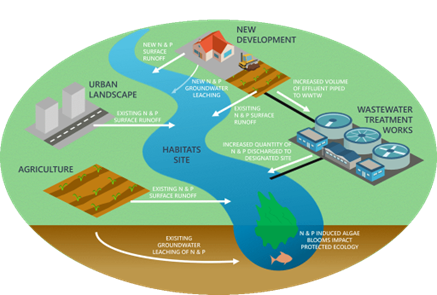Nutrients Fixes
- Details
Roy Pinnock and Grace Pinault examine the Government's proposals for addressing the issue of nutrient neutrality.
Our recent article highlighted the clarity from the Wyatt judgment on the legal framework for nutrient assessment, habitats assessment and the precautionary approach. The Government’s 20 July 2022 Written Ministerial Statement now provides measures to tackle the underlying issue in four ways, the last of which will be a bitter pill for those relying on existing permissions in affected areas.
1. Upgrade Duty
Water and sewerage companies in England will be placed under a statutory duty to upgrade wastewater treatment works to the highest technically achievable limits by 2030 in nutrient neutrality areas, in a way that tackles the dominant nutrient(s) causing pollution at a protected site. This will be introduced through an amendment to Levelling Up and Regeneration Bill. These undertakers are already ‘competent authorities’ with a duty to help protect, conserve, and restore Habitats sites under the Habitats Regulations but the new duty is a requirement to act rather than to operate in a particular way when deciding to act.
The costs of these upgrades will presumably be passed onto to consumers in the affected catchments or more generally. It also remains to be seen how uses which are ‘consuming’ the greatest waste water treatment capacity (agriculture) will pay.
The issue for applications and local plan examinations will be:

- what the technically achievable limits are (and whether the duty requires delivery at all costs or is subject to feasibility and therefore cost considerations);
- what certainty there is in each catchment of those limits being achieved by the 2030 deadline (particularly having regard to forecast changes in non-residential – unmitigated – sources of nutrient flows);
- what treatment capacity expansion means in terms of new forms of development and extended facilities.
2. Nutrient Mitigation Scheme
The Government will direct Natural England to establish a Nutrient Management Scheme (NMS) from Autumn 2022 alongside Defra:
- Defra and DLUHC will provide funding to pump prime the scheme to frontload investment in mitigation projects, including wetland and woodland creation.
- Natural England will accredit mitigation delivered through the NMS, enabling LPAs to grant planning permission for developments which have secured the necessary nutrient credits.
- Natural England will deliver the Scheme by establishing an ‘Accelerator Unit’, with the support of Defra, DLUHC, the Environment Agency and Homes England supported by existing (£100,000) funding from DLUHC for affected areas.
- The scheme will be an option to discharge mitigation requirements more efficiently and is intended to work with the emerging private market in mitigation land.
The Autumn details of the NMS will be important, including the approach to pricing the cost of mitigation and the land component of that.
3. New Permissions
Government will update planning guidance to address housing land supply concerns: making clear that judgements on deliverability of sites should ‘take account of strategic mitigation schemes and the accelerated timescale for the Natural England’s mitigation schemes and immediate benefits on mitigation burdens once legislation requiring water treatment upgrades comes into force’.
Careful thought will be needed by those relying on this guidance on:
- the immediate benefits of the prospective 2030 date;
- how authorities will address the kind of issues raised in Wyatt and noted above on the level of certainty that specific levels of mitigation will be achieved by 2030.
4. Existing Permissions
A thorny issue has arisen on the approach to subsequent approvals, including reserved matters approvals (RMAs), for schemes that escaped nutrients issues (and therefore mitigation costs) at the initial consenting stage. Several authorities have adopted a clear position that reviewing the position again is necessary. Legal Opinions have disagreed. The Wingfield (Canterbury) case has given licence to argue otherwise, in support of the tougher line.
The WMS is clear that schemes with RMAs and condition discharges (basically any scheme) will require review where:
- the environmental circumstances have materially changed as a matter of fact and degree (including where nutrient load or the conservation status of habitat site is now unfavourable) so that development that previously was lawfully screened out at the permission stage cannot now be screened out; or
- development that previously was lawfully screened in but judged to pass an Appropriate Assessment cannot now do so because the mitigation (if any) secured is not adequate to enable the competent authority to be convinced of no adverse effect on integrity of the habitats site.
From a policy perspective, this (1) reduces regulatory risk for decision makers and developers but adopting a position that makes it hard for objectors to may hay with, (2) increases burdens for developers, and (3) secures a wider pool of those paying for mitigation than just new development.
It remains to be seen whether opposing views of the law will result in (probably doomed) challenges to the new guidance.
Roy Pinnock is a partner in the Planning and Public Law team and Grace Pinault is a trainee solicitor at Dentons. This article first appeared on the firm's Planning Law Blog.
Sponsored articles
Walker Morris supports Tower Hamlets Council in first known Remediation Contribution Order application issued by local authority
Unlocking legal talent
Legal Director - Government and Public Sector
Contracts Lawyer
Lawyer (Planning and Regulatory)
Locums
Poll












































